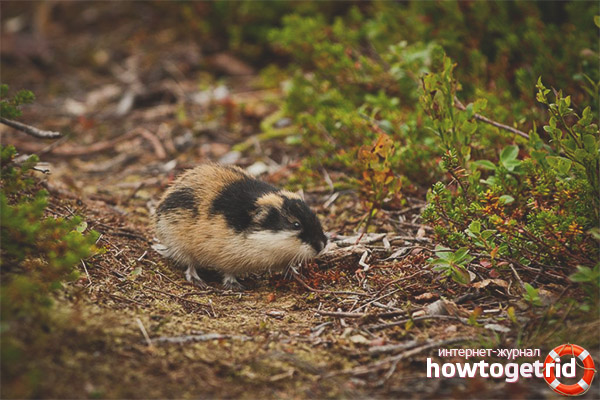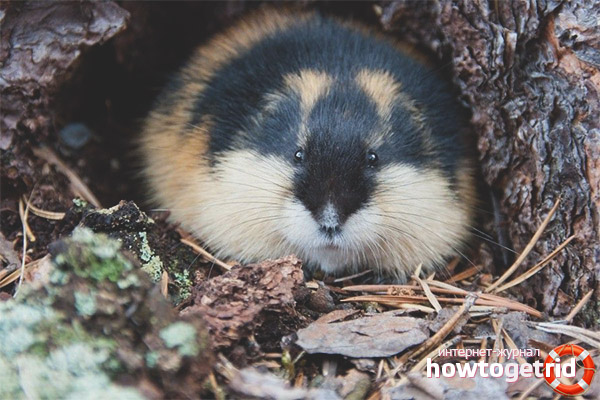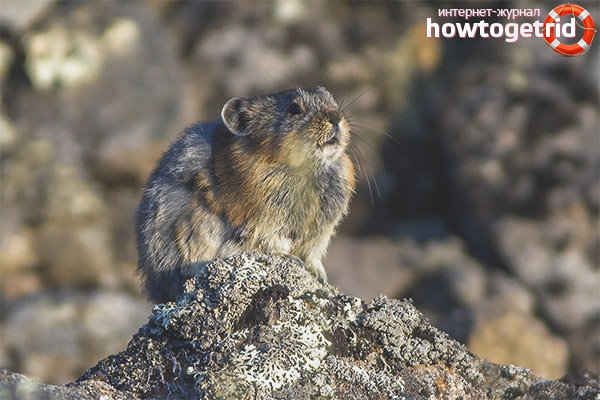The content of the article
Lemmings are small rodents that are members of the hamster family (Cricetidae). These animals, as a rule, live in the northern zones under a layer of snow, and together with voles and muskrats they form a subfamily of voles (Arvicolinae). Lemmings are common in the tundra, alpine and mountain wastelands of Scandinavia and Russia.
Description
The length of lemmings is about 13-18 centimeters, and weight - 23-34 grams. The animals have a fairly rounded shape, long soft fur with a brownish or black color. These rodents have a very short tail, small hairy muzzle, short legs and small ears. They have flattened claws on their first toes of their forepaws, which help them dig in the snow.
Lemmings, like other rodents, prefer to live in groups, but some of them can be lonely and unite only for the purpose of reproduction or migration.
What do lemmings eat
Lemmings are herbivores that feed mainly on herbs and moss. They can also sometimes make their way to the snowy surface, in search of berries, leaves and roots. Rodents constantly grow incisors, which means that they can consume food that is much tougher than their usual food.
Habitat and habits
The smallest mammals of the northern latitudes, lemmings are a key element of the Arctic ecosystems. Their population fluctuates very much, reaching a climax every 4 years, and falls almost to extinction. These small animals occupy a key place in the menu of ermines, arctic foxes, white owls and skuas.
A long Arctic winter is a critical period for lemmings, which, unlike many rodents in the temperate zone, do not hibernate. Surprisingly, these small warm-blooded animals can remain active throughout the Arctic winter without dying from the cold. The small size of their appendages (ears, paws and tail) helps to lose less heat, and their coat is thicker in winter than in summer. As winter approaches, lemmings build large round nests of finely chopped grass from the surface of the soil, providing additional isolation. Snow also provides the necessary insulation for rodents that live in the subnival space (under the snow) and practically do not reach the surface. For example, in northern latitudes, the temperature at the border of the snow cover is still tolerant, in contrast to the temperature on the surface of the earth, and this factor is critical for the survival of rodents.
Features of lemmings
Fluctuations in the number of populations have been known for a long time, they reach a maximum approximately every 4 years.Many reasons were found for these fluctuations, from changes in the influence of the sun to the state of snow. It is likely that weather conditions play a decisive role. Winter is problematic for lemmings, and the amount of snow, the time and place of its accumulations still affect their survival.
One of the first hypotheses put forward by a sharp decline in the population is that the regular alternation of cycles from small to large numbers of individuals occurs as a result of the interaction of lemmings with predators. That is, when there are a lot of animals acting as victims, the predator decreases their number and then begins to starve. However, the problem is also considered from the opposite side. It is known that the snow owl nesting coefficient and the survival rate of young Arctic foxes are related to the number of rodents. For example, a very small number of fox cubs survive a decline in the population of lemmings. A generation of foxes born during the rodent fertility boom period supports the fox population, which is gradually declining in size, until the next peak in the lemmings demographic cycle.
According to another theory, the population of these small animals periodically decreases due to epidemics. The denser the population, the faster infections are transmitted from one individual to another. However, no diseases were found in all declining populations.
Another theory is the interaction of lemmings with food sources. Becoming more numerous, rodents eat up all the vegetation that surrounds them until it runs out. Hunger kills a large number of individuals, and thereby allows the vegetation to grow again, and the cycle begins again. It is known that the quantity and quality of available food varies depending on the demographic cycle of lemmings, but a causal relationship has not yet been proven.
Also, fluctuations in the population can be associated with changes in the behavior of the animals themselves. It is known that the average weight of individuals varies from one phase of the cycle to another. In several species of small mammals, the largest individuals are born in spring. This enhances social interactions between animals, which leads to stress, which creates a hormonal imbalance that interferes with reproduction. Stress itself can lead to more deaths. Lemmings are usually aggressive towards each other. If a change in behavior occurs towards aggression, a large number of individuals will die.
Lemmings migrate sporadically every few years when a population explosion occurs. In mild winters, early spring and late autumn months, when food is abundant, breeding occurs quickly, animal survival is high and their numbers increase.
It is often mistakenly said that lemmings commit mass suicides by jumping from rocks. But this is not so. It was from the rapid breeding that the famous myth of their mass suicides took root. An increase in the number of rodents leads to mass migration, rodents are simply looking for new territories for life. Obstacles in their path, such as boulders, rivers, rocks, or ravines, force lemmings to risk their lives for migrations. They travel dozens (if not hundreds) of kilometers, overcoming meadows, fields, as well as streams and rivers. However, when animals reach the coast, they think they are able to swim across a body of water and reach the opposite shore. Lemmings are good swimmers, but they cannot calculate their strength. And, unfortunately, many of them die from exhaustion. And therefore, when people find hundreds of dead lemmings on the beaches, they think that rodents commit mass suicides.
Breeding

The proportion of lemmings that breed in the summer after birth varies greatly from year to year and is apparently related to population density.If the population is small, then breeding continues until September, but when there are too many lemmings, they can stop mating in July.
Rodents can breed in the winter. It is still unclear how such a small mammal, already under severe heat stress, can find enough energy to mate in the middle of the Arctic winter, and what factors determine the timing of this winter breeding.
Rodents usually live alone. In winter, some species of lemmings gather in groups and live in nests together. In the period when there is no snow anymore, females usually lead a sedentary life in a certain territory, in contrast to males who randomly move in order to find food. In one season, the female can bring up to 6 litters (from 5 to 6 individuals). If there is enough food, then they can breed under the thickness of the snow. The first offspring usually occurs when the females are already 2-3 months old. Males are able to produce offspring already at 6 weeks. They live on average from 1 year to 2 years.
Survival of lemmings
Lemming is not easy to survive in the wild, as they very often become prey of predators. In the snowless season, Arctic foxes, ermines, snowy owls, wolves and skuas need food, and lemmings make up most of their catch.
In general, human activity does not threaten lemmings, with the exception of those works that involve digging land. For example, rodents can affect the construction of mines, oil wells and other industrial facilities. Bad weather can also cause them to die. In the fall, early cold weather in the absence of snow can be fatal. Winter nests can be flooded, and summer burrows are blocked by ice when frost abruptly replaces the warm season. It is also known that individuals suffer from a number of infectious diseases and can tolerate various parasites.
Lemmings are an important link in the relatively simple life chain of the tundra and help to better understand how even this simple ecosystem can really be complex. The burrows they dig transform Arctic soil. Their eating habits change the composition of the plant world. In addition, predator survival depends on them, because populations of arctic foxes and foxes are directly correlated with a population of lemmings.
Video: Lemming (Lemmini)











Submit